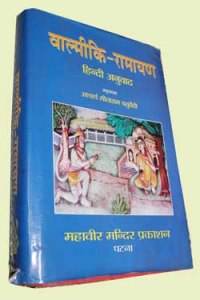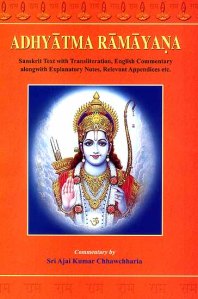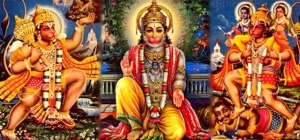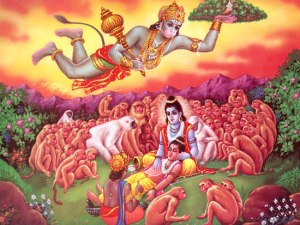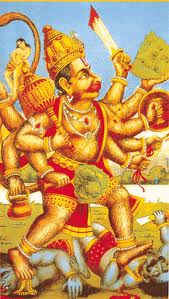(http://www.mahavirmandirpatna.org) and (http://www.exoticindia.com)
I don’t remember how, by whom and when I was introduced to the stories of Ramayan. I must have read it the first time in Chandamama. Then, I read the Hindi translation of Adhyatm Ramayan and Valmiki Ramayan. My grandparents were devoutly religious people and they had both the books at home. As they actually read these Ramayans I could also have access to them. I liked them enough to read the complete Hindi part, and kept going back for more. Somehow, I ended up losing both the books most definitely before I had turned fifteen. I don’t know the specifics, but I lost them. Much later in my life, inspired by my eldest uncle’s apt and exact use of couplets from it, I did buy a Ramcharitmanas but could never read it. I still hope and aspire to quote from the Manas.
Before we go any further, a digression must be allowed. I always wanted to be like him. More than that, I always wanted to be as logical, erudite and as good and forceful speaker as him. His grounding in Ramcharitmanas made it possible for him to quote extensively and aptly from it. He could always come up with the right kind of anecdote, or couplet, to prove his point. He used to tell us stories too: stories that had some kind of moral hidden in them. I miss those stories and wish that the greatest story teller in our family finds time and opportunity to read mine.
Maryada Purushottam Ram is the hero of Ramayan. Goswami Tulsidas sang his praise in his Manas that was to become the core religious text of the Hindus of Northern India. It is more than just a religio-spiritual text. Dharm, unlike its equivalent word in English, has never been divorced from the worldly affairs in Hinduism: neither in theory nor in practice. Manas was to provide models for a good society, king, family, man, woman and various social roles one plays in one’s lifetime. It’s an encyclopedia of religion and worldly conduct. In this, as far as the function of the text is concerned, it may be compared to Quran and Hadis combined (pardon my ignorance if I’m wrong, there’s no intention here to hurt anybody’s religious sentiments) as it is a guide for both final salvation and the daily mundane affairs in the sansar that is maya.
I like the story and its hero: it’s his story and both are good. I love Hanumanji. I have always been in love with the idea of the god who symbolizes strength. As a child (in my pre-atheist phase) I used to believe in his anti-ghost powers. It was Goswami Tulsidas who had composed the Hanuman Chaalisa that I used to recite every day and had learnt it by heart in those days. I took the whole text in the Devnagri script from http://hanumanchalisa-hindblogs.blogspot.in/2010/03/hanuman-chalisa-hindi.html and pasted it down.
हनुमानचालीसा
दोहा
श्रीगुरु चरण सरोज रज, निज मनु मुकुर सुधारी
बराणु रघुवर बिमल जसु, जो दायकु फल चारि
बुद्धिहीन तनु जानिके, सुमिरौं पवन कुमार
बल बुधि विद्या देहु मोहि, हरहु कलेश विकार
चौपाई
जय हनुमान ज्ञान गुन सागर
जय कपीस तिहुँ लोक उजागर॥१॥
राम दूत अतुलित बल धामा
अंजनि पुत्र पवनसुत नामा॥२॥
महाबीर बिक्रम बजरंगी
कुमति निवार सुमति के संगी॥३॥
कंचन बरन बिराज सुबेसा
कानन कुंडल कुँचित केसा॥४॥
हाथ बज्र अरु ध्वजा बिराजे
काँधे मूँज जनेऊ साजे॥५॥
शंकर सुवन केसरी नंदन
तेज प्रताप महा जगवंदन॥६॥
विद्यावान गुनी अति चातुर
राम काज करिबे को आतुर॥७॥
प्रभु चरित्र सुनिबे को रसिया
राम लखन सीता मनबसिया॥८॥
सूक्ष्म रूप धरि सियहि दिखावा
विकट रूप धरि लंक जरावा॥९॥
भीम रूप धरि असुर सँहारे
रामचंद्र के काज सवाँरे॥१०॥
लाय सजीवन लखन जियाए
श्री रघुबीर हरषि उर लाए॥११॥
रघुपति कीन्ही बहुत बड़ाई
तुम मम प्रिय भरत-हि सम भाई॥१२॥
सहस बदन तुम्हरो जस गावै
अस कहि श्रीपति कंठ लगावै॥१३॥
सनकादिक ब्रह्मादि मुनीसा
नारद सारद सहित अहीसा॥१४॥
जम कुबेर दिगपाल जहाँ ते
कवि कोविद कहि सके कहाँ ते॥१५॥
तुम उपकार सुग्रीवहि कीन्हा
राम मिलाय राज पद दीन्हा॥१६॥
तुम्हरो मंत्र बिभीषण माना
लंकेश्वर भये सब जग जाना॥१७॥
जुग सहस्त्र जोजन पर भानू
लिल्यो ताहि मधुर फ़ल जानू॥१८॥
प्रभु मुद्रिका मेलि मुख माही
जलधि लाँघि गए अचरज नाही॥१९॥
दुर्गम काज जगत के जेते
सुगम अनुग्रह तुम्हरे तेते॥२०॥
राम दुआरे तुम रखवारे
होत ना आज्ञा बिनु पैसारे॥२१॥
सब सुख लहैं तुम्हारी सरना
तुम रक्षक काहु को डरना॥२२॥
आपन तेज सम्हारो आपै
तीनों लोक हाँक तै कापै॥२३॥
भूत पिशाच निकट नहि आवै
महावीर जब नाम सुनावै॥२४॥
नासै रोग हरे सब पीरा
जपत निरंतर हनुमत बीरा॥२५॥
संकट तै हनुमान छुडावै
मन क्रम वचन ध्यान जो लावै॥२६॥
सब पर राम तपस्वी राजा
तिनके काज सकल तुम साजा॥२७॥
और मनोरथ जो कोई लावै
सोई अमित जीवन फल पावै॥२८॥
चारों जुग परताप तुम्हारा
है परसिद्ध जगत उजियारा॥२९॥
साधु संत के तुम रखवारे
असुर निकंदन राम दुलारे॥३०॥
अष्ट सिद्धि नौ निधि के दाता
अस बर दीन जानकी माता॥३१॥
राम रसायन तुम्हरे पासा
सदा रहो रघुपति के दासा॥३२॥
तुम्हरे भजन राम को पावै
जनम जनम के दुख बिसरावै॥३३॥
अंतकाल रघुवरपुर जाई
जहाँ जन्म हरिभक्त कहाई॥३४॥
और देवता चित्त ना धरई
हनुमत सेई सर्व सुख करई॥३५॥
संकट कटै मिटै सब पीरा
जो सुमिरै हनुमत बलबीरा॥३६॥
जै जै जै हनुमान गुसाईँ
कृपा करहु गुरु देव की नाई॥३७॥
जो सत बार पाठ कर कोई
छूटहि बंदि महा सुख होई॥३८॥
जो यह पढ़े हनुमान चालीसा
होय सिद्ध साखी गौरीसा॥३९॥
तुलसीदास सदा हरि चेरा
कीजै नाथ हृदय मह डेरा॥४०॥
दोहा
पवन तनय संकट हरन, मंगल मूरति रूप।
राम लखन सीता सहित, हृदय बसहु सुर भूप॥
I still remember most of it, only a few words go missing (and I strongly feel they used to be different in my version!) At the end we used to say: Siyawar Ramchandra ki jai, Pavansut Hanuman ki jai. There were many lines that had special appeal for a child of twelve. I have italicized those lines in the text above. The chalisa, or the set of forty chaupais, ends with the information that whosoever recites it a hundred times shall be freed of all bondage and be happy. The one who reads the Hanuman Chalisa definitely becomes knowledgeable and gains power. Just before these lines one comes to know that whosoever remembers the strong Hanumanji, his problems and pains will be removed.
The number hundred that appears in there had a special and dual significance for me. It was a definite number and it was definitely a number set on the repetitions that could be achieved. My mother had assured me of the same and I had taken it literally in the beginning. So, I started counting the number of recitations every day. I still remember, although faintly, how exhilarated I used to feel as I inched towards that magic number. I also remember my elation at having completed the prescribed number of repetitions.
Hanumanji played a very central role in the narrative of Ramayan. It was he who had come to ascertain whether the two warrior brothers roaming in the forest were friends or enemies of Sugreev. It was he who then took his lord to his king and thus started a long fruitful relationship. It was he to whom Ram gave his signet to prove his identity to Sita, as he knew that his greatest devotee would surely reach his wife. Then he went across the ocean keeping the ring in his mouth, underwent many adventures and finally reached Sita and burnt the whole city in which she was kept prisoner. He then played a very central role during the epic Ram-Ravan battle.
There’s one chaupai about Hanumanji‘s bringing the life giving herb to save Laxman after Meghnaad had used the lethal Shakti on him. In a way he had saved his lord Ram on that day too, as he had neither hope nor will left to live after that. I had always liked his image that shows him carrying the whole hill upon which Sushen had told him the herb would be. His inability to locate the herb was due to demon magic, and not because any lack of intelligence, because he is the ocean of knowledge and qualities, as is mentioned in the opening chaupai of the chalisa.
(blogspot.com)
One part of a chaupai mentions his taking a gigantic form while killing the demons. He is the font of strength and devotion, and, the most important thing is that he is a celibate. This makes him the guardian deity of wrestlers and bodybuilders of north India. Jai Bajrang Bali is the most popular cry that comes out of akhadas and gyms, especially when someone is trying something beyond their power or skills. They call upon their faith in the font of strength and draw strength from its font. One more digression is rising its head here. It’s about faith, its loss and its need. In a talk with a colleague of mine, I mentioned my loss of faith. He returned with his personal anecdote linked with Hanumanji. There’s a Hanuman Temple just outside the campus of Lucknow University, by river Gomti. He told me with surety and honesty that he had felt the need of asking for something only thrice in the days that he spent in Lucknow, and he got what he needed all the three times. This bolstered his faith in Hanumanji in particular and in faith in general.
His faith and mine (while it lasted) have a definite relation to the poet and social engineer: Goswami Tulsidas. He played a very seminal role in strengthening the Ram Bhakti cult in the Medieval Northern India. Devotion to Hanumanji was an implied and central factor in the cult. The edifice of devotion to these incarnations of Vishnu and Shiv respectively was raised on the foundation that he had laid.

This work is licensed under a Creative Commons Attribution-NonCommercial-NoDerivs 3.0 Unported License.
